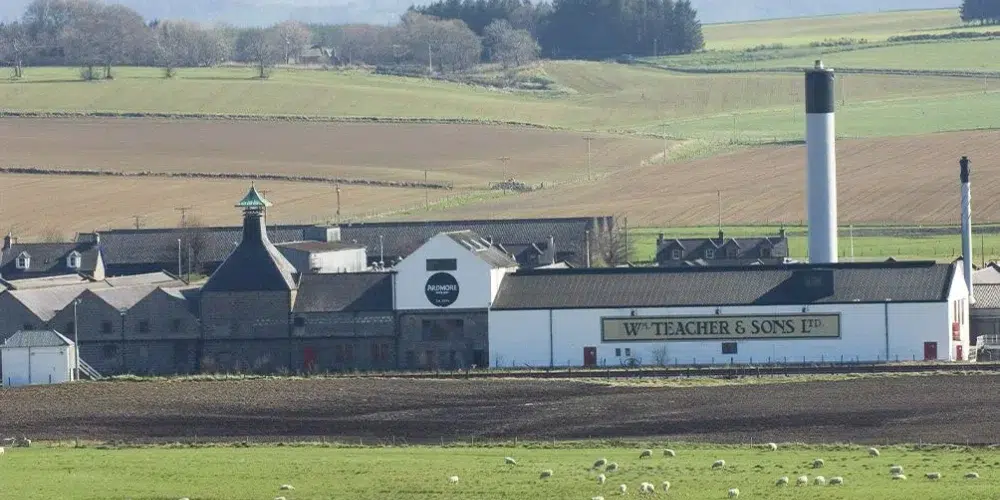
Ardmore Distillery
- Scotland
- http://ardmorewhisky.com/
- +441464831213
- Ardmore Distillery, Kennethmont, Huntly AB54 4NH, United Kingdom
History of Ardmore Distillery
Founding and Early Years
Ardmore Distillery was established in 1898 by Adam Teacher, the son of William Teacher, a noted figure in the whisky blending business. The distillery’s location in Kennethmont, near the railway between Aberdeen and Inverness, was strategically chosen for its accessibility. It was primarily founded to supply malt whisky to the blended industry, specifically to Teacher’s own blend. The distillery has a significant history tied to its original purpose, which was to ensure a steady supply of malt for the Teacher’s Highland Cream blend, a globally recognized product.
Expansion and Development
The distillery underwent significant expansion post-World War II. The original pair of stills, initially installed in 1898, were doubled in 1955 and then doubled again in 1974, bringing the total to eight. This expansion was necessary to meet the increasing demand for Teacher’s blend. Ardmore was one of the last distilleries in Scotland to switch from coal-fired to steam-heated stills in 2001, a testament to its traditional approach to whisky making.
Ownership Changes and Current State
The distillery has seen several changes in ownership over the years. In 1976, Ardmore joined Allied Distillers’ portfolio when Teachers merged with the group. Later, in 2006, it was sold to Beam Global, along with Teacher’s and Laphroaig. As of 2014, Ardmore is part of the Beam Suntory portfolio. Ardmore has always had a focus on producing malt for the Teacher’s blend, which has limited its presence as a single malt. However, it has garnered a dedicated following, especially for its independent bottlings.
Production Characteristics
Ardmore’s production involves sourcing water from springs on Knockandy Hill and using barley peated to approximately 10 ppm. The distillery has a unique setup with onion-shaped stills and maintains a traditional cooperage for cask creation and repair.
Most of Ardmore’s whisky production is used for blended whisky, particularly Teacher’s Highland Cream, with the distillery having one of the largest capacities in Scotland. However, Ardmore also produces its own single malt, known for its peated quality which is distinct from the typical Speyside malts. The single malt range includes “Traditional Cask” and “Ardmore Legacy,” with some unpeated versions used exclusively in blends.
Environmental Initiatives
Ardmore is actively involved in environmental initiatives, notably in the WhiskHy project. This project focuses on extracting hydrogen from the distillery’s wastewater using renewable energy, potentially leading to the elimination of carbon emissions from the distilling process. Beam Suntory, Ardmore’s parent company, aims for net-zero carbon emissions across all its distilleries by 2040.
In conclusion, Ardmore Distillery, with its rich history and commitment to traditional whisky-making methods, has played a crucial role in the Scotch whisky industry. While primarily focused on producing malt for Teacher’s blend, its single malt expressions and environmental initiatives demonstrate its adaptability and continued relevance in the modern whisky world.
Ardmore Distillery’s Distillation Process
The Beginning: Water & Barley – The process starts with two basic ingredients: water and barley. Ardmore sources its water from the springs on Knockandy Hill. Imagine this water, enriched by the Scottish landscape, meeting the finest barley. It’s like a natural symphony waiting to start!
Malting with a Peaty Twist – Now, Ardmore adds a special touch to the malting process. Unlike many Speyside distilleries, they infuse the barley with peat smoke, giving their whisky that unique, smoky character. Picture the barley grains basking in the peaty aroma, like sunbathing in the Scottish highlands!
Mashing and Fermentation – The malted barley then goes into a mash tun. Here, it’s mixed with hot water, coaxing out the sugars. This sweet liquid, called ‘wort’, is then fermented. During fermentation, yeast is added, and the magic begins. It’s like a little party where the sugars are transformed into alcohol.
Distillation: The Copper Dance – The fermented liquid, now called ‘wash’, enters the copper pot stills. Ardmore uses traditional copper pot stills for distillation. Picture these stills as grand copper dancers, twirling and refining the wash into a fine spirit.
Maturation: The Art of Patience – This new spirit is then placed in oak casks to mature. Ardmore mainly uses American oak barrels that once held bourbon. The whisky rests, slowly developing its complex flavours. It’s a test of patience and craftsmanship, as the whisky matures and gathers a wealth of flavours.
The Final Product: Ardmore Whisky – After maturation, the whisky is ready. Each sip of Ardmore’s whisky is not just a taste of Scotch, but a journey through a time-honoured process infused with the uniqueness of the Scottish highlands.
Ardmore Distillery Tour Information and Experience
Ardmore Distillery, located in Aberdeenshire, Scotland, does not offer public tours as a general practice. Unlike many other distilleries, Ardmore doesn’t have an open visitor centre for walk-in guests or routine public tours.
What To Do Nearby Ardmore Distillery
Crathes Castle: Explore the stunning 16th-century castle and its beautiful gardens, including a rose garden, a herbaceous border, and a wildflower meadow. This historical site offers a glimpse into Scotland’s past and is renowned for its horticultural beauty.
Aberdeenshire Farming Museum: Discover the region’s agricultural history at this museum in Old Deer, Scotland. It’s an informative spot for learning about local farming practices and the rural way of life in Scotland.
Braemar Castle: A 17th-century castle known for its unique architecture and rich history. Operated by local volunteers, it offers guided tours that reveal its fascinating past.
Lochter Activity Centre and Fishery: Located just a mile west of Oldmeldrum, this centre offers a variety of activities including archery, zorbing, and trout fishing. It’s ideal for those looking for outdoor adventure and relaxation.
Glen Garioch Distillery: Experience another facet of Scotland’s whisky heritage at Glen Garioch, known for its rich history and intriguing whisky-making process.
Tolquhon Castle: An impressive ruin near Oldmeldrum, offering a chance to explore its detailed architecture and uncover hidden compartments used in medieval times.
Pitmedden Garden: Wander through serene 17th-century gardens, marveling at the landscape design and tranquility of this beautiful space.
Royal Deeside Railway: A heritage railway line 14 miles from Aberdeen. It offers an opportunity to indulge in trainspotting and learn about the railway’s royal connections.
Tomnaverie Stone Circle: A Bronze Age stone circle, providing a unique insight into Scotland’s ancient history and a chance to enjoy stunning hilltop views.
Craigievar Castle: A 16th-century castle, often associated with the inspiration for Disney’s Cinderella Castle, showcasing a distinctive pink exterior and a wealth of historical artefacts.
Dunnottar Castle: The ruins of this 15th-century castle hold a notable place in Scottish history, particularly during the Jacobite Uprising. It’s an atmospheric site to explore the past.
RSPB Scotland Fowlsheugh: Home to over 130,000 seabirds, this coastal nature reserve is ideal for birdwatching and enjoying breathtaking cliff views.
Frequently Asked Questions
What restaurants are near Ardmore Distillery?
The Market Cafe: It has a rating of 4.4 stars on Google Maps. For reservations, you can reach out to them on their phone at +44 1466 794795. Their address is The Ward, Huntly AB54 4QU, United Kingdom.
The Bank Cafe & Restaurant: This restaurant has a rating of 4.2 stars. You can contact them at +44 1466 543103 for reservations. The address is 2 The Square, Huntly AB54 8AE, United Kingdom.
Alford Tandoori Takeaway: With a rating of 4.6 stars, this restaurant can be contacted at +44 1975 564086. The address is Watchmaker’s Ln, Alford AB33 8EW, United Kingdom.
What hotels are near Ardmore Distillery?
The Seafield Arms Hotel: It has a rating of 4.6 stars on Google Maps. For reservations, you can reach out to them on their phone at +44 1542 841604. Their address is 17-19 Seafield St, Cullen, Buckie AB56 4SH, United Kingdom.
The Craigellachie Hotel: This hotel has a rating of 4.5 stars. You can contact them at +44 1340 881204 for reservations. The address is Victoria St, Speyside Way, Craigellachie, Aberlour AB38 9SR, United Kingdom.
Haughton Arms Hotel: With a rating of 4.6 stars, this hotel can be contacted at +44 1975 564219. The address is Main St, Alford AB33 8WA, United Kingdom.



